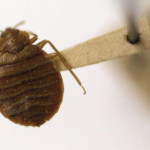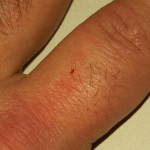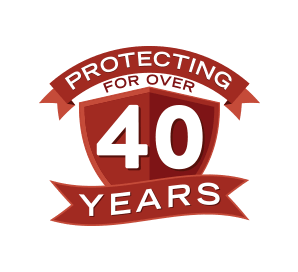- CALL US: 905.318.1242
Bedbug Treatments

The average size of an adult bedbug.
The Action Pest Bedbug treatment can be simplified into 3 sections: Pre-Treatment, Treatment, and Post Treatment. Do you need immediate assistance with a bedbug problem? Contact us immediately!
Pre Treatment
Identification of Pests

A bedbug feeding on a finger.
The first step is to correctly identify whether bedbugs are the problem. Bedbugs can be mistaken for other pests and rodents, especially when homeowners notice bites or red marks after waking up. Proper identification is critical for effective treatments.
Detection of Bedbugs
If in doubt about a bedbug infestation, dog detection is one of the most effective methods in detecting bedbugs. K9’s specially trained to sniff out bedbugs are 80% more efficient than conventional methods, as well as being very cost effective.
Preparation for Bedbug Treatment
Before bedbug treatments can commence, the following steps MUST be categorically followed by the homeowner or commercial property managers.
- Gather, Hot Wash, & Hot Dry
- All machine-washable textiles, must be gathered in bags to be washed in hot water and dried on high.
- This includes all clothing, bedding and anything in storage in the affected area/room.
- Anything that cannot be put in the washer should be run through the hot drier for at least 30 minutes.
- Clean Storage
- Segregate cleaned items into sealed clean plastic bags, making sure to throw out any bags used to carry the bed bug infested sheets.
- Vacuum
- Carefully vacuum – mattresses, bed frames, carpeting and baseboards
- Clean-Up
- Remove anything hung on walls
- Empty out all drawers. Bed bugs are attracted clothes and wood over plastics and metals.
- Improving Accessibility
- Move furniture at least a foot from the walls
- Unplug all electronics
- Unlock closets, rooms, or any other spaces
Bedbug extermination depends on good preparation.
It is imperative these steps are carefully followed to prevent future infestation threats.
Bedbug Treatment Procedure

Young bedbug nymphs next to a penny.
Thorough treatments require 2-3 visits, and follow the preparation phase.
- First Visit
- Premises are gassed
- Mattresses and box strings are encased in certified bed bug covers, salvaging the mattress and preventing future bed bug penetration
- Follow-Up
- Visits 2 and 3
- These follow up visits are conducted in two week intervals, to monitor the situation and as precautionary measures.
Common Bedbug Treatment Options:
Traditional Bedbug Treatment:
- Insecticides are the traditional bedbug treatment method. They are available in three broad categories; residual, fast-acting and dust, which helps to increase their overall effectiveness.
- Action Pest uses micro injectors to spray a fine mist. This tool is especially helpful in more confined spaces like furniture, mattresses and walls.
Heat Treatment:
- Heat is often used as a means of removal in the form of steamers and heating units. Studies, have shown that bedbugs exposed to a constant heat of 120°F for 30 minutes die. Unfortunately, steamers cannot guarantee eradication of all bedbugs or their eggs. Another option, similar to steaming are large heating units.
- Heat treatments are situation specific and in many cases will fail to penetrate tight spaces like- wall voids, electric equipment, appliances and wall paintings.
Combination Treatment:
- An integrated approach is the recommended option by professionals. It offers long-term targeted results, that are environmentally sensitive and continually effective. The Action Pest professionals have over 30 years of experience to monitoring, eliminating and preventing future pest threats.
- Action Pest’s offers a patent Integrated Pest Management Program (IPM) which combines chemical and non-chemical treatments into a long-term management program focusing on monitoring and prevention. It is a environmentally sensitive, MOE (Ministry of Environment) approved, as well as odorless and water based (when possible) solution, that utilizes four different insecticides.
Learn more about Treatment Options.
Post Treatment
Over the course of two follow up, post-treatment visits, professionals will inspect and monitor the situation, ensuring that there are no surviving bedbugs or eggs. Homeowners, in the meantime, may sleep in their own beds.
Results
The bedbug explosion in Southern Ontario and North America is a serious problem. A combination approach utilizing chemical and non-chemical treatments, at periodic intervals is the recommended option. Successful treatment, however in any case, hinges on your cooperation. As the bedbug situation continues to escalate reach out to us anytime 7 days a week for expert advice.
Bedbug Treatment Types Pro and Cons
| Method | Description | Pro | Con |
| Micro injector | Used for sprays | · Highly targeted
· Penetrate deeper into materials |
· Can’t target inside of walls |
| Heating Units | Heat application | · Chemical free
· Kills all bedbug cycles · Penetrates into items · Quick treatment time · Some articles may have to be discarded |
· Most expensive
· Intensive Prep work required · No residual effects · Not applicable to heat sensitive articles · Fails to penetrate deep harborages |
| Steam | Heat application | · Chemical free
· Kills Bedbugs on direct contact · Targets small cracks and crevices |
· No residual effects
· Certain articles cannot be targeted · Some articles may have to be discarded |
| Traditional
(Chemical) |
Insecticides | · Most cost effective
· Residual effect · Highly Targeted |
· Bedbug develop resistance & may be resistant to chemicals
· Some articles may have to be discarded |
| DIY | Do it yourself | · Readily available in hardware stores | · Extremely high failure rates
· No residual effects · Time consuming · Challenging to control · Require expertise and sometimes a license |






